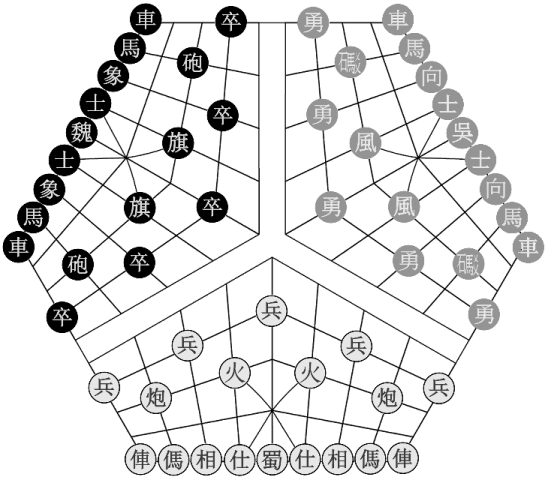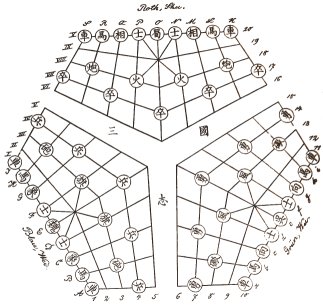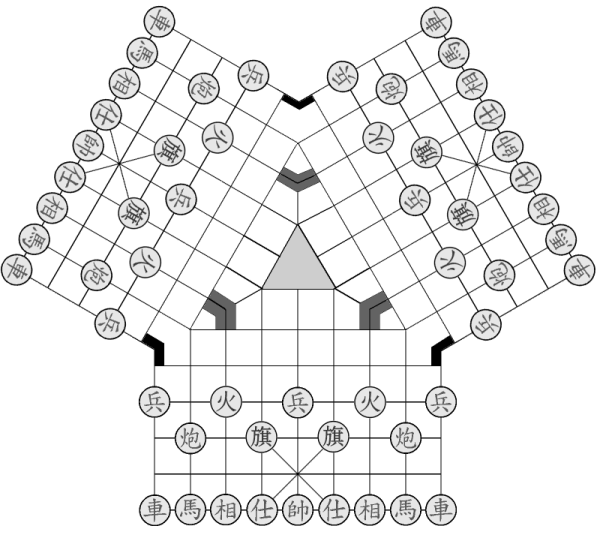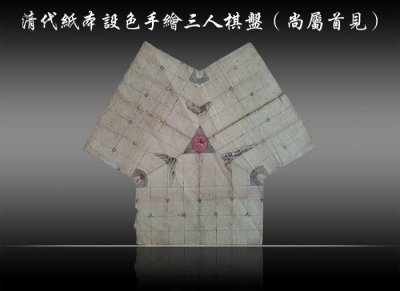Sanguo Qi (Three Kingdoms Chess)
& Sanyou Qi (Three Friends Chess)
SANGUOQI:

Sanguoqi, 三國棋 Three Kingdoms Chess, is a xiangqi variant for three players.
The chessboard is an hexagon with 3 groups of 9x5 intersections each. There are 135 intersections in total. Each camp is separated from the others by a river and has a 9-points palace in its center.
The colors of the pieces are blue, red and green. Each player has 18 pieces: the classical 16 of regular Xiangqi and 2 new ones which stand on the same file than the Cannons.
The new pieces have different names depending on their side: Fire (Huo), for red, Flag (Qi) for blue, Wind (Feng) for green. The "royal" pieces are Generals which bear the name of the historical Chinese kingdoms: Shu for red, Wei for blue, Wu for green.
Several other green pieces have different names too. The Soldier is a Brave (Yong), the Cannon is a more powerful Pao and the Minister is another Xiang meaning Protector.
The Sanguoqi board
This game is mentioned in H.J.R. Murray's book "A History of Chess" on pp 133-134. He cited von Möllendorf who wrote an article in German, titled "Das Schachspiel der Chinesen", in 1876. This original work is available here. It contains this illustration:
-
Xiangqi pieces keep their moves. Fire/Flag/Wind moves 2 steps orthogonally followed by 1 step diagonally. It can't jump over an intermediate man.
-
A piece crossing the river on the central column can choose to enter either left or right ennemy camp.
See here for more detailled rules.
SANYOUQI:

Sanyouqi, 三友棋 Three Friends Chess, is another historical form of 3-Handed Xiangqi.
There, the board is arranged around a triangle. The central triangular zone is named "Ocean" (Hai). Chariots and Horses are not allowad to pass this zone. Other zones at the junctions between the three parts are called "Mountain" (Shan) and "City Wall" (Cheng). Cannon is not allowed to pass these zones.
Compare to regular Xiangqi lineout, two Soldiers are withdrawn and replaced by two Fires which moves 1 forward diagonal step only. They can't go back (This recalls the weird move given to the Xiangqi Soldier by Cheng Hao in the 11th century).
In front of the Palace there are two Flags again. The rule for their move can be interpretated in several ways. We understood that they move 2 steps straight ahead as long as they are in their camp and, then, when in the ennemy side, they can move 1 step in any direction. (Some believe that they can move like a Chariot or like a Horse in the ennemy camp).
The detailed rules of the Three Friends Chess are available in the book "Ancient China recreation including figures" (Tushui Zhongguo gudai youyi) 圖說中國 古代遊藝 ISBN: 9576687039, 2002, which records many Chinese Ancient Game. His author is Cui yuequan 崔樂 泉 (b. 1959) a researcher of China sports history. He gave this illustration:
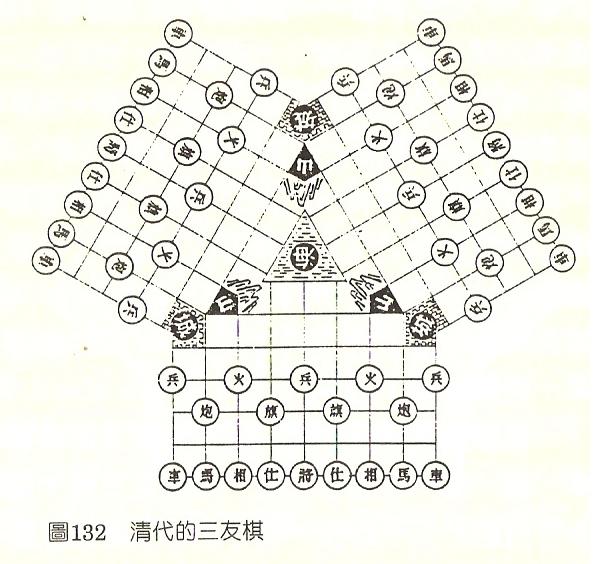
The Chinese Chess History book "Some Textual Research on Chinese Chess" (Zhongguo Xiangqishi congkao) 中國象棋史叢考 ISBN: 9787101037043, 2003, also records the board of Three Friends Chinese Chess, but lacks the detailed rules. His author was Zhu nanxian 朱南 銑(1916-1970), a very reliable scholar drowned (???) after drunk during Cultural Revolution. His book is posthumous, covering Chinese Chess History during Song Dynasty to Qing Dynasty.
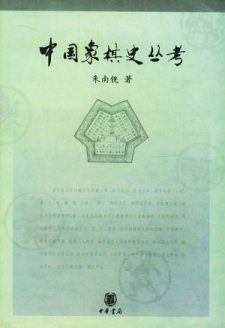
Zhu nanxian reported that in Luoyang in 1932, people found a strange chess. They believed that it was the Three Kingdoms Chinese Chess of Southern Song Dynasty. Later, the equipment was lost, only the hand-drawn picture remained. The board illustrated in this book is the following (which is also given by Cui yuequan):
In his book, Cui yuequan provides the following poem of Zheng jinde, the supposed inventor (see below) depicting the coarse rules and the tactics of Sanyouqi:
鄭晉德 (棋詩) (Qi shi, Chess poem)
三友爭雄,一海朝宗。負山連城,連連崇崇。
將
士相車,馬炮列同。增益旌旗,士角東西。
五
兵去二,易火間重。先明大勢,再運神工。
維
彼將帥,法象九宮。我車既攻,山城邊通。
我
馬亦同,山城越從。炮隔汪洋,大建奇功。
火
向小尖,一步斜沖。不許回頭,敢爾橫縱。
旗
出兩步,前驅直衝。入彼巖疆,呈八面鋒。
律
既有條,用亦無窮。三人當局,審量興戎。
我
出彼應,迴圈始終。相彼左右,乘虛而入。
孰
強孰弱,是交是攻。先輸反背,協同向風。
隨
我所用,佐我軍容。兵行詭道,濟私假公。
神
機妙算,決勝此中。
It is possible to translate, more or less, using this wonderful translation website. For instance, the line from 旗出兩步 gives the move of the flag.
See here for more detailled rules.
A recent board sold on an auction web site (thanks to YRD for this information):
HISTORY:
These games are 3-handed variants of xiangqi. They are supposed to symbolize the Three Kingdoms War when Wei, Shu and Wu kingdoms fought in the 3rd century A.D for the domination of China. It started in 220 with the fall of Han empire. Wei finally defeated Shu but then power was seized by Sima Yan soon after. Sima Yan founded the new Jin dynasty in 265 before defeating Wu in 280. These events considerably influenced the Chinese culture. Then, it is not surprising that it gives the frame for a 3-players chess game.
Three Kingdoms Chinese Chess Sanguoqi would have appeared under the Southern Song dynasty (960-1279) but the two books which described it (Ruled description of Three Kingdoms, Sanguo tuge 三國圖格 and Description of Three Elephants Game, San xiangxi tu 三象戲圖) are lost.
This is controversed. For Leventhal (Chess of China), Sanguo Qi was invented under the Qing dynasty (1644-1911). The presence of a Banner among the pieces is a sign of the Mandchu influence (banner "has a distinctive place in the Qing dynasty ’s Manchu military organization. The banner system combined both civil and military administrative functions and provided the means of controlling the subject Chinese and Mongol peoples as well as the Manchu tribesmen").
Three Friends Chinese Chess Sanyouqi would have been invented by Zheng Jinde 鄭晉德 from Shexian in Anhui province living during the reign of Kangxi Emperor of Qing Dynasty (r.1661-1722). He was a friend of Zhangchao 張潮, one of the greatest essay writers in China. Zhangchao wrote a book called "Collection of volumes in the Present Age" (Zhao dai cong shu) 昭代叢書 in 1697 giving the rules of Zheng's game. Zhu nanxian made the opinion that maybe Zheng jinde had seen the book Sanguo tuge and copy or amend Sanguoqi to make his invention.
During the reign of Qianlong Emperor (r. 1735-1796), another game book, "Swineherd’s Chat" (Muzhu xianhua) 牧豬閒話 from Jin xueshi 金學詩, also mentioned this game. The rules were again mentioned in Liang shaoren 梁紹任's essay book: "Dissimilar essays in Autumnal Rain-thatched hut" (Liang ban qiuyuan suibi) 兩般秋雨盦隨筆. Liang shaoren lived during Daoguang Emperor (r.1820-1850).
MODERN VARIATIONS:
In Modern China, 3-Handed Xiangqi is often re-invented. Many people think themselves as the first inventor of those variants...
Three of these can be found on boardgamegeek.
DING QI:
"Tripod Chess", 鼎棋, is based on triangular cells. (See this link here)
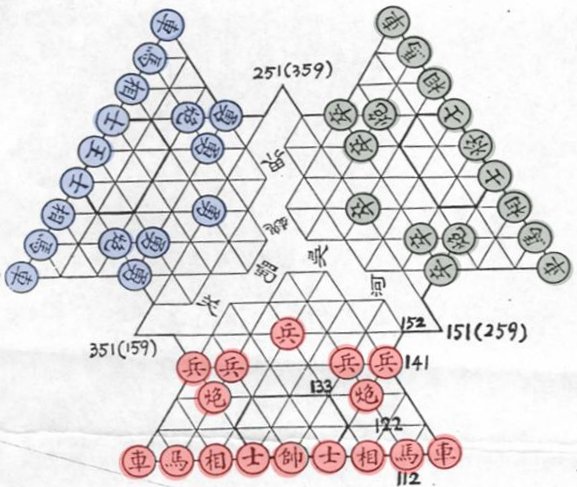

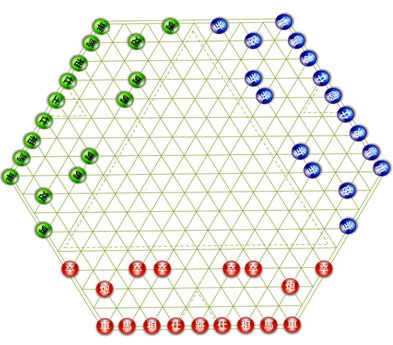
This modern 3 Kingdoms Chess belongs to Hans Bodlander. More photographs here.

A retired professor in China invents a new Three Kingdoms Chess in 2009.
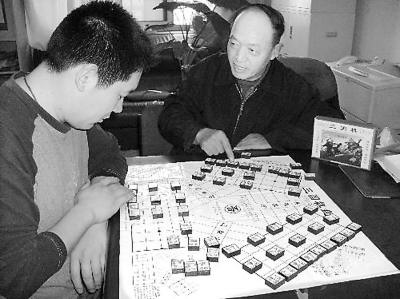
SANRENQI (Three Men Chess) 三人棋:
This one is a bit different. It is a commercial variant which was available (2009-2010) on a Chinese website, Sanplay (dead link). Details can be found on this other Chinese website.
It follows the normal three players Chess with the following exceptions:
1. Horses and Elephant have no trap. Since there is no river, Soldiers are promotted.
2. Cannons are not allowed to move into other player's territory at every player's first move.
3. There is a neutral country called Han, not moving, not belonging to any of the three players until a regicide or an alliance occurs. Han has three Chariots, one Cannon, and one General named Emperor Xian of Han.
4. There are three spots in the Han's palace. Each one is connected to its closest player.
5. Ally: If a horse of one player steps onto the spot marking another player, both players become allies until the third player is destroyed. However, this third player will get at once the control of Han until the end of the game.
6. Regicide : If a horse of one player captures Emperor Xian of Han, this player gets the control of Han forces until the end of the game. Simultaneously, the other two players become allies.
(If a horse of a player steps onto its own spot, nothing happens)
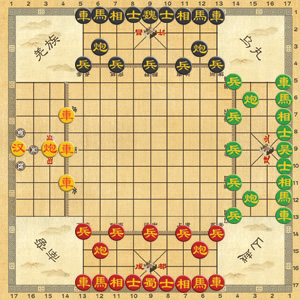
There are also several Four players versions of xiangqi. Those four-handed variants are modern games.
For the historical Seven players variant, follow this link.
More links:






